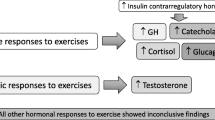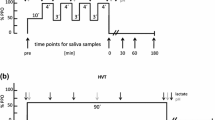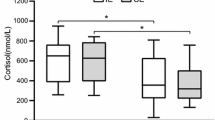Abstract
The hypothalamo-pituitary-adrenal axis is involved throughout the exercise-recovery cycle. Nevertheless, differences in hormone responses during early recovery between sedentary and endurance trained subjects are not well known. The aim of this preliminary study was to monitor plasma cortisol and adrenocorticotropic hormone (ACTH) concentrations both during and after the end of running exercise performed by four endurance trained adults (marathon men) compared to four sedentary subjects. Two parameters, i.e. intensity and duration, were changed on 4 consecutive days. The 1st day (D0) was spent in the laboratory: all blood samples were obtained at rest to determine diurnal variations of each hormone. On the following days (D1–D4) the subjects exercised: D1 and D2 brief (20 min), light (50% maximal heart rate HRmax, D1) or strenuous (80% HRmax, D2), D3 and D4 prolonged (120 min), light (D3) or strenuous (D4). In both groups, neither brief (D1, D2) nor prolonged light exercise (D3) induced any significant variation in plasma ACTH or cortisol concentrations. Plasma ACTH and cortisol concentrations increased only if the exercise was intense and prolonged (D4). The training factor did not modify the intensity or duration thresholds for the activation of the pituitary-adrenocortical response to exercise in the conditions of our experiment. However, during immediate recovery from the four exercise regimens, the plasma ACTH concentrations of the marathon men were constantly above the values of the sedentary subjects, although plasma cortisol concentration remained similar in both groups. As an indirect means of evaluating the relationships between ACTH and cortisol we compared the areas under the cortisol and ACTH curves (AUC) from 0.5 to 3.5h during recovery from D1 to D4 compared to D0 at the same time. Cortisol AUC were similar in the sedentary subjects and marathon men although the ACTH AUC were different in the sedentary subjects and marathon men, suggesting a change in the pituitary-adrenal relationship at some yet indeterminate level. During the immediate recovery from exercise whatever its intensity, the magnitude of the ACTH response was increased in the trained subjects but with a reduced effect upon its target, the adrenal glands. This phenomenon has not been described in the literature. Two non-exclusive phenomena may be involved, i.e. a decreased adrenal sensitivity to ACTH stimulation, and/or a decreased hypothalamo-pituitary axis sensitivity to cortisol negative feedback.
Similar content being viewed by others
Author information
Authors and Affiliations
Additional information
Accepted: 6 August 1996
Rights and permissions
About this article
Cite this article
Duclos, M., Corcuff, JB., Rashedi, M. et al. Trained versus untrained men: different immediate post-exercise responses of pituitary adrenal axis . Eur J Appl Physiol 75, 343–350 (1997). https://doi.org/10.1007/s004210050170
Issue Date:
DOI: https://doi.org/10.1007/s004210050170




